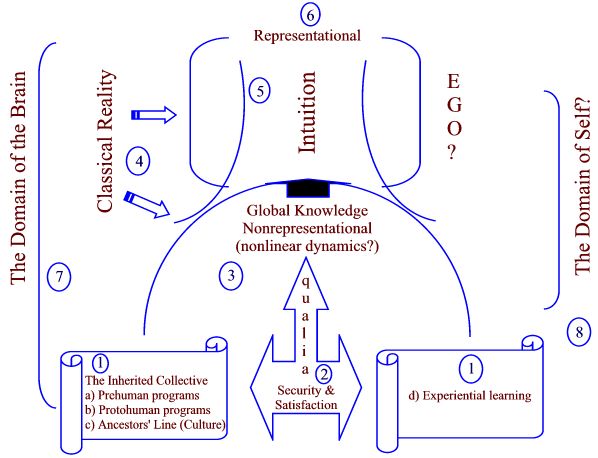
1) Adaptational data developed during evolution and common to many species (a), to the entire hominid line (b),and to sociocultural organizations (c), constantly interact with data from the individual's experiential learning (d), in ways consistent with the findings from evolutionary psychology, with Edelman's reentry model, with the principles of nonlinear science and with mythical literature, starting from the Egyptian description of the "soul".
2) These data are processed for basic survival value and are in this way categorized and weighted with qualia (affective loading). This phase reflects the value-categorization concept of Edelman, the valence-arousal concepts of Kaszniak, the foundation for the affect-linking process described by Gelernter, and the overall central role of affectivity in thought production described by Damasio. It also represents the progressive interaction between Psyche and Eros, the need for an Eros domain to relate to Psyche and intimately connect with her.
3) The data constitute our entire knowledge and are available at an unconscious, nonrepresentational level in a global and ever-changing way that is precursor to conscious awareness. The process operates along nonlinear parameters in the phase-space of the global maps and functional cluster of Edelman, or Scott's phase-
space of creativity, or the mythical castle of Apuleius.
4) Under activation from classical reality these data eventually give emergence (nonlinear dynamics) to representational constructs
5); the transformation may be perceived as intuition (or insight,
6), particularly when the thought process runs in a low-focus state. The representational constructs, or mental images, allow for internal as well as external communication and interaction and may involve discrete neuronal networks within the context of a globally activated (binding) state of consciousness. Both non-conscious and conscious conditions are within the domain of the brain
7): the Self may be coded in a nonrepresentational as well as a representational mode
8). The Ego expresses that sphere of the self that experiences conscious awareness. It includes peripheral phenomena of which the subject
is aware but in a vague and indefinite sense, as fringe phenomena and unnamed "feelings".